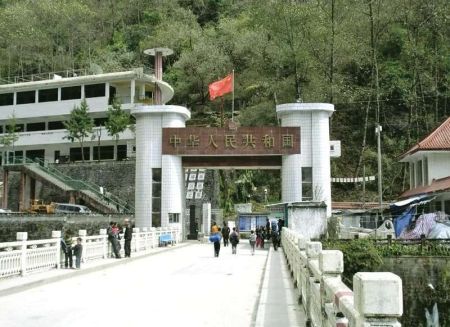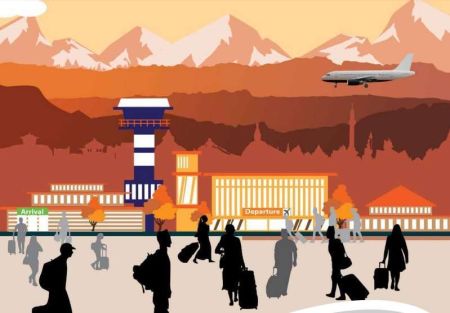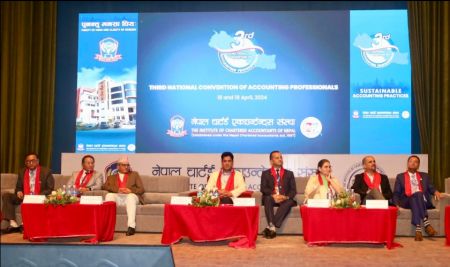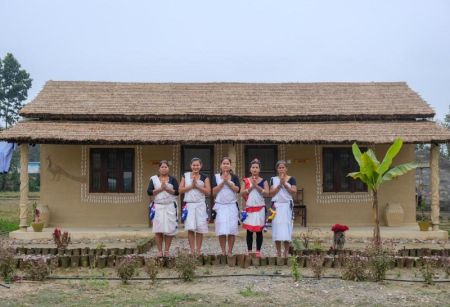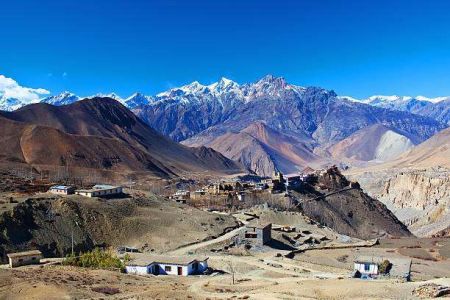 With a network of 51 branches and 73 ATM outlets, Kist Bank Limited is slowly but surely inching towards becoming a premier bank. With an existing customer base of 300,000, the bank is focusing on providing faster and friendlier services. Kamal Prasad Gnawali, the Managing Director of the bank says, “Kist Bank stands for customers’ convenience and support. We always look forward to serve them by understanding their needs and designing tailored products.â€
With a network of 51 branches and 73 ATM outlets, Kist Bank Limited is slowly but surely inching towards becoming a premier bank. With an existing customer base of 300,000, the bank is focusing on providing faster and friendlier services. Kamal Prasad Gnawali, the Managing Director of the bank says, “Kist Bank stands for customers’ convenience and support. We always look forward to serve them by understanding their needs and designing tailored products.†Â
Kist Merchant Banking and Finance was initially incorporated as a ‘C’ category financial institution in 2003 for undertaking limited banking activities. It started commercial banking activities as Kist Bank Limited from 7 May 2009. Starting with seven employees in 2003, it has 582 people in its ranks today. The bank has deposits to the tune of Rs 16 billion and loans of Rs 13 billion in current fiscal year 2010-11. In the last fiscal year 2009-10, the deposits and loans stood at Rs 15 billion and Rs 12.5 billion respectively.
Â
The bank is driven by values of efficiency in operations, integrity and a strong focus on catering the needs of every customer by offering high quality and cost effective products and services. The management team along with its dedicated employees operate in a highly automated environment. It has put in substantial efforts and investments in acquiring the best technologies available to build necessary banking infrastructure. The bank’s superior information technology and communication systems enable delivery of prompt and quality services.
Â
Due to its wide network of branches, a sizeable population has access to its banking services where most value added services come free of cost. Gnawali says that the transition to a full-fledged bank in 2009 was a major turning point in the company’s history. “It was a challenge in terms of manpower, market perception and expectations,†he admits. Having pioneered many products in Nepal’s financial sector, the bank these days does not pursue matters aggressively. It rather believes in a controlled business approach and focuses on individuals and SMEs as its clients.
Â
A young bank with its employees averaging 26 years of age, it believes in a democratic style of working. The staff equation is well taken care of by maintaining a good balance between senior and junior employees. The human resource department at the bank conducts training every week to increase the efficiency of its workforce. Kist Bank believes in having a participative management and ensures easy access and direct approach among its employees. Gnawali was the First Runner Up at the prestigious MAN Awards 2010 under ‘Manager of the Year’ category. “Any award that I receive is because of the bank and not for me as an individual,†he says giving credit for his personal success to the bank’s management team.
Â
Commitment to CSR
For Kist Bank, corporate social responsibility (CSR) has always been a top agenda. It means embracing responsibility for the impact of its activities on the environment, consumers, employees, communities, stakeholders and the public at large. Gnawali explains, “It helps us manage our business responsibly and sensibly for long term sustainable banking.â€
Â
Some CSR commitments of the bank include:
Cash Assistance to Cyclist Puskar Shah
The bank honoured cyclist Puskar Shah as its goodwill ambassador and assisted him during his world cycling tour of 150 countries. It also provided a cash assistance of Rs 442,417 to Shah for his expedition to Mount Everest. Shah took to the summit the national flags of the countries he visiteda as well as a banner with the Kist Bank’s logo.
Society of Economic Journalists (SEJON)
The bank has provided a cash assistance of Rs 500,000 to SEJON to establish a revolving fund to provide annual award to three economic journalists. The bank hopes that this award will be an additional incentive to the journalists.
Traffic Awareness Programme
With the objective to raise the awareness among the commuters and drivers of public transport vehicles in urban areas, the bank has provided an assistance of Rs 240,000 to create 20,000 traffic awareness stickers. These stickers were pasted on public vehicles in coordination with Namuna Sadan and Media Agency.
Cataract Surgery
The bank provided Rs 12,500 for cataract surgery of five ophthalmic patients in an eye camp organised with the initiation of Reyukai Masunga Eye Hospital, Banepa.
Gaurishankar Campus
The bank provided cash and kind equivalent to Rs 84,000 for an enlightening discourse programme on Bhagawat Geeta aimed at collecting funds to convert Gaurishankar College at Charikot, Dolakha into a University.
Street Lights
Four street lights worth Rs 24,000 were installed at main road in Kalanki, Kathmandu in coordination with LOYUS, an NGO.
River Conservation and Tree Plantation
Under the initiation of National Nature Conservation Fund, the bank provided Rs 15,000 for planting 100,000 trees on the banks of Bagmati River.
Children Memorial Monument and Garden
A financial assistance of Rs 200,000 was made to Vishwo Shanti Prachar Manch, an NGO, for the construction of children memorial monument and garden near the entrance of Tribhuvan International Airport.
Plans
The bank says it has always been giving prime focus on physical infrastructure and human resource development. It has laid emphasis on acquiring state-of-the-art information technology to ensure the most secure transaction and remain competitive. It has enhanced its distribution outlet to reach un-banked areas and serve people with banking services.
Â
A few key plans of the bank are:
* Having acquired VISA’s Associate Membership in 2011, the bank is set to launch VISA accredited credit and debit cards this year. Presently, the bank has 150,000 debit card holders on its rolls.
* Last year, the company focused on expansion and building internal strength. Situation permitting and with a favourable environment, the bank’s dream this year is to turn multinational and extend its banking services to countries that have sizeable Nepali Diaspora.
* Increase customer base to 500,000 from the present 300,000.
* The bank currently provides services to customers from its own buildings in Anamnagar, Birtamod, Damak, Biratnagar and Narayangarh. It wants to have own bank buildings at all possible branch locations. A multi-storey building which will house the bank’s main branch and head office is presently under construction at Anamnagar, Kathmandu.
* Too many players in the market have resulted in quality manpower crunch. To counter this, the bank plans to develop a competitive workforce to undertake higher responsibilities. Its training and development department bears the responsibility to train qualified individuals hired by the bank.
* Expand its remittance business making it accessible to a larger section of the population.
* Develop and launch innovative and customer-friendly products to meet the needs of people deprived of banking services. The bank has a research and development wing that carries out research effecting this direction.
* Support the investors to start large infrastructure development projects in the country.
* The bank also plans to promote micro finance to develop self sustainable enterprises and make individuals self-reliant.
Vision and Mission
Kist Bank’s vision is to become the best bank based on operational excellence and superior financial performance. It remains open to the idea of a merger. The bank aspires to become a leading bank by providing best quality financial products and services to its customers, enhancing shareholders value, creating excellent growth opportunity for its employees and contributing to the economic prosperity of the country.
Â
 Kamal Prasad Gnawali
Kamal Prasad Gnawali Managing Director
Kist Bank
“The transition to a full-fledged bank in 2009 was a major turning point in the company’s history. It was a challenge in terms of manpower, market perception and expectations,â€
Kist Bank Briefs
* The authorised capital is Rs 5 billion and the issued and paid-up capital Rs 2 billion.
* 60 per cent of the paid-up capital is held by the promoters and remaining 40 per cent by the general public.
* The shares of the bank are listed at Nepal Stock Exchange Limited (NEPSE) as ‘A’ category shares.
* The seven-member Board of Directors (BOD) has three Directors representing the promoters, two representing the general public and one representing the Professional Director.
Â
SWOT Analysis
Strengths:
* Young and career-oriented workforce
*Good relations between Promoters and Directors
* Quick implementation of ideas
* A sound infrastructure
* Impressive range of products
* Promoters’ trust in the institution
Weaknesses:
* Comparatively new entrant in the market
* Limited exposure in corporate banking
Opportunities:
* Foray into corporate banking
* Further business expansion and development
* Build on existing infrastructure
Threats:
* Mushrooming competitors
* Political instability
*Unhealthy competition






